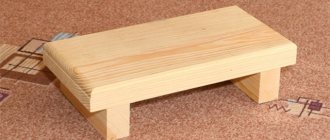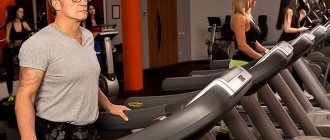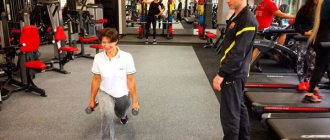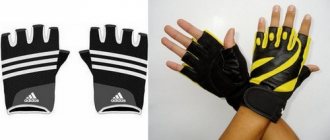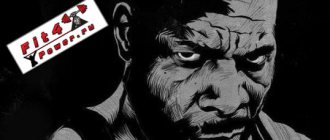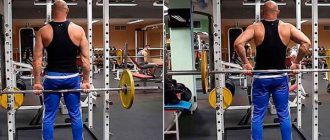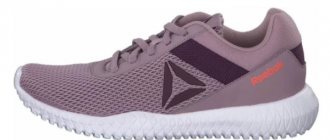When we plan the loads and write down the upcoming work in our training diary, we are full of optimism. We write down exercises and upcoming approaches, anticipating possible gains and long-awaited progress. However, even when we begin to prepare for training in advance, we cannot always influence its result, just as we cannot count on it to go as we expected.
Why is this happening? Because life sometimes makes its own adjustments and, unlike training, it is not always possible to plan it as we would like. Today you slept well, you were praised at work, you didn’t get stuck in traffic on the way home, and the day was clear and sunny? This means you’ll get to the gym in a great mood and maybe even set a personal record in some exercise. If so, then congratulations - everything is great!
What is VSD and why does pathology develop?
Vegetative vascular dystonia is not a disease. Or rather, one of the controversial diagnoses with the absence of subjective symptoms. In general, people experiencing fatigue and weakness have about 10 syndromes and 150 objective signs. In ICD 10, the term VSD is also not used. The pathology is classified as somatophoric dysfunction (SVD) and is classified as a disorder of neurohumoral regulation of systems and organs. Therefore, when making a diagnosis, differential diagnosis is carried out.
- If there are complaints about the heart, the coronary vessels are checked.
- In case of cervical osteochondrosis, fainting, intracranial pressure, spinal column, and central nervous system are examined.
- In case of hypertension, essential and symptomatic hypertension are excluded.
If no organic lesions are noted, VSD is diagnosed.
Replenish fluid loss
Physical activity involves active loss of fluid. And, naturally, it needs to be replenished. This same action increases the body's recovery rate after exercise because it supports nutrient delivery and improves metabolism. You should drink especially plenty of fluids after training in hot weather.
It is advisable to drink acidified drinks, for example, still mineral water with lemon or lime juice and the addition of stevia powder (a natural sweetener). You can also resort to isotonic drinks. These are fluids that provide a person with water and electrolytes, which leave the body through sweat.
Important!
Isotonic drinks are presented on the market in two forms - dry concentrate in cans and liquid concentrate in bottles. The taste can be very diverse - from forest cherry to exotic passion fruit
The main thing is to pay attention to the composition when choosing; it should not contain acesulfate and saccharin. These are cheap sweeteners that do not make the composition balanced, moreover, they are dangerous to health
It is better to opt for drinks that contain salts, glucose polymers, dietary supplements and vitamins.
You are taking too much weight
Perhaps you want to get results as soon as possible, for which purpose you deliberately increase the weights during training. As a result, you only get fatigue and emasculation, with which it is impossible to achieve the desired results. Therefore, during classes, listen to your condition. A pulse above 120 beats/min will indicate that you are lifting too much weight. during exercise, as well as shortness of breath that does not go away during rest periods between sets. Also, you cannot complete the specified number of repetitions or start doing exercises in jerks using the dynamics of movements. Trying in this way to deceive muscle fatigue.
Method 10. Plan your workouts
For training to be successful, it is necessary to clearly define the goal and, accordingly, develop a rational action plan that will allow you to achieve the desired results faster. It is quite difficult to draw up a training plan on your own, especially for a beginner, so at the first stage you should contact a specialist with a specialized education who has extensive experience in sports. Only regular and systematic training will make your dream come true, but never overwork and lack of a plan!
Expert commentary
Tigran Stepanyan, athlete, fitness trainer, holder of 5th dan in Shotokan karate, international master of sports, vice world champion, President of the Shotokan Federation in Armenia
Everyone knows the fact that regular training and fitness classes inevitably lead to physical fatigue. The more tired a person is, the faster he loses the desire to exercise. But if you learn how to properly restore strength, your zeal for achieving your goal will only intensify.
Immediately after training, you should allow your muscles to cool down. Do some simple stretching exercises, run on the treadmill for a few minutes, but at a low pace
In 15-20 minutes, the body will have time to restore part of the lost energy reserve and bring the heart rate in order, which is no less important for physical condition and health in general.
Rub your muscles well, this also promotes rapid recovery. If possible, join a gym or fitness club that has a swimming pool. Water procedures will have a positive effect on the overall tone of the body.
Regardless of what equipment you use during your workouts, you must replenish lost fluid. Drink plenty of water. Drinking plenty of fluids will normalize water balance, accelerate the absorption of nutrients and the synthesis of enzymes required for the restoration of muscle tissue.
If you have been involved in sports for a long time and you have a desire to build muscle mass, stock up on special protein shakes. But be very careful in your choice. Be sure to consult your doctor and buy cocktails only from trusted manufacturers.
Do not forget that protein is a building material for our muscles, which means it should be present in the diet in optimal quantities; it is better to consult a doctor on this issue. You also need to compensate for the lack of minerals by taking pharmaceutical mineral complexes.
Listen to your body, do not overload yourself with long and high-intensity workouts, control the degree of stress. If you feel very tired, stiff and have severe muscle pain after each workout, stop and consult a specialist.
Training should make you happy, not frustrating. Only in this case will they bring benefits to the whole body and allow one to achieve good results.
What to do to avoid trouble?
The easiest way to prevent a problem is to prevent it. Therefore, rather than harming your training and suffering from pain after exercise, it is better to follow some rules to avoid problems. So, in order to avoid getting sick during training, you need to follow the following simple rules:
- Follow nutritional rules. Don't eat a lot before training. The last meal should be 2 hours before training. Also, poor health is guaranteed if you exercise on an empty stomach. It is also not recommended to eat immediately after training; you need to wait at least 1 hour.
- Although it was said above that it is important to drink enough water, you should not overdo it. Half a liter of water during training is the norm. It is recommended to drink water in small sips.
- It is important to breathe properly while performing exercises. Since this not only affects the final result, but also the condition of the body as a whole. Since abdominal breathing helps reduce the gag reflex.
- Does not recommend taking on an excessive load, especially for beginners. The level of load must correspond to the physical capabilities of the person.
- It is important to take breaks between exercises. And also do not neglect the number of these approaches. After all, the load on the body will be much greater if you do 20 repetitions in one approach than if these repetitions were done in 3 approaches.
- For those with low blood sugar, it is recommended to drink sugary drinks during exercise, but not carbonated ones.
If you don’t follow these rules, then you shouldn’t wonder why something hurts and how to stop it. Because this is impossible. Only by following these rules can you avoid pain, nausea and dizziness. But if the cause of the discomfort is something else, then it is better to immediately undergo a medical examination. Since poor health is often a sign of some kind of disturbance in the functioning of the body.
Signs of the disease
The causes of severe weakness are due to functional disorders of the autonomic nervous system and are similar in symptoms to organic diseases of the organs or system. The patient feels constant fatigue, unmotivated irritation and aggression. Concerned:
- absent-mindedness;
- sweating;
- sudden trembling throughout the body;
- tremors in the hands, nerves in the legs:
- cloudy head;
- lack of concentration;
- panic fears, dizziness;
- sleep disorders, dark circles under the eyes.
The patient is unable to adequately perceive space and information from the environment. Sometimes they worry:
- arrhythmia or cardiac arrest as after coffee;
- weakness in the neck;
- lump in the throat;
- symptoms as in cervical osteochondrosis - pain in the back of the head, head.
At the moment of an attack, your hands fill with lead, your legs become weak. A person has only one desire - to lie on the sofa and curtain the windows. When the weather changes, migrating pains are annoying. Symptoms may alternate or overlap. Trembling of the limbs gives way to cramps and body aches.
General weakness of the body and a heavy head are the main symptoms by which the pathology is diagnosed, which occurs in 97% of cases in children and adults. Due to nervous conditions or endocrine disorders, the disease develops in a teenager after stress or during puberty due to hormonal surges. The same factors serve as a trigger for the development of VSD in men and women of all ages.
Causes of physical weakness after training and how to avoid it
Staying in good physical shape can be difficult, especially if you start from scratch. The decision to take up sports requires considerable willpower and great desire. When performing physical exercises, the entire load falls on the muscles and heart. Due to exhaustion and waste of energy after training, a person feels severe weakness, muscle aches and drowsiness. These symptoms do not always indicate pathology.
Sometimes very intense exercise quickly exhausts the body. To avoid such conditions, you should follow some rules and consult an experienced doctor.
Method 6: Eat Healthy Foods
Post-workout nutrition depends solely on the purpose of your workout. If the goal is weight loss, experts recommend turning to foods that contain a high amount of protein or a minimal amount of carbohydrates, for example, boiled skinless chicken breast or steamed pollock.
If the goal of training is to gain muscle mass, you need to combine proteins and carbohydrates in a ratio of 1:4. However, the exact numbers depend on the intensity of the workout and the time spent on it, and, of course, health. This ratio is appropriate for absolutely healthy people who train intensively for an hour.
If you decide to resort to sports nutrition, consult your doctor first, because it has a number of side effects. Nowadays, there are three types of sports supplements - for building muscle mass, burning fat and recovering from physical activity. Also on sale you can find multicomponent complexes aimed at solving several problems, and pre-workout complexes of amino acids and vitamins designed to increase endurance, speed up metabolic processes and maintain hormonal levels.
Roskontrol experts assure that there is no universal recommendation for choosing sports nutrition
When purchasing, it is important to focus on the training program, the goal you want to achieve, and the recommendations of the trainer. You should also remember that you cannot base your diet on sports nutrition, they are only an additive that affects metabolic processes
It is imperative to replenish reserves of all vital substances by eating meat, fish, poultry, cottage cheese, cereals, vegetables and fruits.
You're not eating right
In order for you to come to training in a good mood and with high tone, it is important to eat 4-5 times a day. At the same time, you should not overeat immediately before training, otherwise the body will take some of the energy to digest food, and you will clearly feel a lack of it. It's better to have a snack an hour or two before going to the gym. And immediately after training, have a snack with protein foods for muscle growth.
Following various diets can also lead to a lack of energy. Strength training is too energy-intensive, and therefore a lack of calories in food can lead to apathy, dizziness and poor health during exercise.
Don’t try to reduce the amount of “slow” carbohydrates in your diet in the hope that this will help you get rid of body fat faster. The muscles will begin to “melt” first, and only then the amount of fat will begin to decrease. Moreover, a lack of carbohydrates can lead to hormonal imbalance, which will have the most unpleasant consequences.
The goal is to be in good shape
In this case, we are not interested in constantly increasing the load, and therefore the question should not arise after how many workouts the muscles will stop hurting. Pain, if it is present, will only be at the beginning of training. Gradually, when the muscles get used to certain loads, they will stop hurting and will maintain their current state without development. If you don’t have a goal to change your body or adjust your shape, then such loads are quite enough to maintain tone and good mood.
A good option for exercise in this case would be Pilates, yoga and aerobics. These exercises develop all muscle groups well without overloading them or causing pain.
Types of training
To answer the question why an athlete feels bad after training, you need to plunge into the training process itself. Not all workouts are created equal.
Among them, there are those that improve your health, and there are those that improve your athletic performance. In the second case, health may suffer.
- Health training.
As a rule, this is a set of light exercises that tone muscles and improve overall well-being. This can be light cardio or moderate strength training that does not stress the body. You won't feel sick after a workout if you exercise at a low intensity. - Warm-up workout.
This is training before the competition. It is characterized by a high speed of performing exercises with a low intensity of the load itself. During such training, hypoxia often develops, and after. - Workout training.
This is a workout using sports equipment that involves working with your own weight. It can overload your body, especially if you don't keep a workout log and push yourself to do more than you're capable of. - Aerobic training.
This is serious cardio. How well you will feel depends on the intensity and timing. Aerobic training is often accompanied by dehydration and all the ensuing consequences. - Strength anaerobic training.
This is a tough workout with heavy weights in the gym. If the body is not prepared for such stress, you will experience a full range of side effects, starting with and ending with loss of consciousness. - Drying workout.
This is a relatively easy workout that can be done both. However, keep in mind that during the drying itself, your body is already in a stressful situation and, as a result, cannot fully recover.
So, some types of exercise will definitely make you feel bad, while others will only make you feel better. However, first of all, how you feel after training is determined not by the load, but by your readiness for this load.
Treatment methods
Many people believe that if weakness in the body does not go away, you need to sleep for a few days. This is wrong. Treatment through drug-induced hypersomnia gives good results only after stress or when circadian rhythms are not observed. Companions of vegetative dystonia - asthenia, fatigue, nerves in the legs, loss of appetite are cured by movement. Sometimes it takes effort to get your body off the couch and out into the park. A morning walk after eating helps treat weakness and hand tremors. Bonuses for the body:
- In the fresh air, the brain is saturated with oxygen.
- Oxidative reactions are activated.
- Pleasant emotions relieve mental stress and activate thought processes like after coffee.
It’s better to walk for kilometers with an artificial smile on your lips. Feelings are controlled by consciousness, so the mood is determined by the energy of the metal level and the internal state. Imitating joy is one of the methods to overcome a stereotypical reaction. This is enough for the brain to give the command to produce endorphins. Emotions of pleasure and joy will heal and calm the nerves and soul.
Recovery training
Sometimes the day after a workout is hard to get out of bed, let alone go to the gym again. But there is no need to give your all for several days in a row. Go for a light jog, play basketball, football or volleyball, ride a bike, do yoga. According to writer and sports nutrition expert Matt Fitzgerald, A Fresh Perspective on Recovery Runs, training slowly while fatigued helps you better adapt to exercise.
The recovery period after training is inevitable. You need new strength and energy to continue playing sports, working on yourself and becoming better. But this period can be shortened with the help of special additives. For example, the energy drink E‑ON BCAA 2000 contains not only amino acids that promote rapid recovery, but also caffeine, guarana and ginseng extract, which will give the body an additional boost of strength. Train and recover effectively.
Method 5. Visit a sauna or steam bath
In addition to cool baths, on the way to recovery after intense training, you can turn to a sauna or bathhouse. These establishments are a great place to relax and maintain health. Don't forget about hot wraps, they also have a beneficial effect on the muscles and also improve the condition of the skin - moisturize, nourish and tighten.
Remember!
Hot wraps have a number of contraindications. They are not recommended for oncology, diseases of the cardiovascular and endocrine systems, varicose veins, thrombophlebitis, lymphovascular diseases, pregnancy, gynecological diseases, as well as in the presence of cuts, wounds and other injuries on the skin.
Fatigue after training. How to deal with it?
Helena Kostina
Writer and expert / Published
Share this page
All of us who play sports are familiar with the feeling of fatigue after a workout. No, I'm not talking about ordinary fatigue that goes away after a few hours or a day. I'm talking about chronic fatigue, which consists of many factors and often accumulates over years. You and I not only train, right? We have a job that takes a lot of energy, we have a family that needs attention, parents and relatives, friends, social projects, studies... I think everyone can offhand name at least three areas in life, in addition to training, where you need to make an effort. strength. But, in addition to physical and intellectual strength, we have emotions. And emotions, as one of the most important manifestations of the psyche, closely influence hormones, and every time there is an emotional experience, there is a surge of adrenaline, then serotonin, then oxytocin... And these hormones, in turn, actively influence our physical condition - then the pressure rises , then on the contrary, it drops, then a surge of relaxation, then muscle tension. And thus, all our psychological problems are also bodily, they also have a bodily expression. And this causes even more fatigue.
Which muscles should ache after training?
Obviously those that your exercises were aimed at. That is, if, when lifting the barbell, your biceps and triceps hurt, then the exercise can be considered completed successfully, you have achieved the desired result. If, during the same exercise, a burning sensation occurs in the back area, you should immediately stop doing it. This means that the execution technique was not followed. Although sometimes a situation arises that a trainee, due to inexperience or lack of understanding, harms his health, much more often the cause of injury is negligence and neglect of safety precautions, which trainers tirelessly repeat in the gym.
What symptoms should not be ignored?
The occurrence of pain during training is not uncommon, and therefore some unpleasant sensations can simply be waited out. But there are some symptoms that should not be ignored. These include the following:
- Incessant cough while doing cardio. Very often, such a cough indicates a risk of asthma. Therefore, if all training is accompanied by an incessant cough, you should immediately consult a doctor.
- I often get headaches when doing strength exercises. People who play sports think that headaches arise from overexertion. However, if a headache always comes when strength exercises begin, then this indicates a blood pressure disorder. And if neglected, it can develop into more serious health problems. However, you should not immediately panic and quit training. Since headaches mainly occur due to improper breathing, improper technique, etc. Therefore, you should carefully monitor your technique and breathing. If this does not help, you should consult a doctor.
- Chest pain. Pain in the chest area indicates a malfunction of the cardiovascular system, so it is better to get checked just in case.
- Pain in right side when running. Many people experience this problem, and the pain usually subsides after a few minutes of rest. However, if after training your side still hurts for a long time, this may indicate problems with the gallbladder.
If you often feel unwell during training, then you should stop training for a while and undergo a full medical examination. Because some ailments are symptoms of serious health problems.
Why do muscles hurt?
During training, the familiar burning sensation is the result of the formation of lactic acid in the muscles. It is a product (metabolite) of the oxygen-free breakdown of glucose in muscles. They need to somehow obtain energy when a sufficient amount of oxygen does not pass through them.
After training, there is no longer a burning sensation, the muscles are moderately sore. For several hours, the muscles experience pleasant fatigue from a lack of nutritional material and energy. When reserves are restored, fatigue goes away. It may take 4-6 hours until this point. The strength is felt again in the muscles, but now it becomes painful.
Anabolic pain is a sign of a good workout. Its presence means that you have given your muscles the load that will lead to progress. This pain goes away up to 7 days. And this period depends on the level of training of the student. If you've tried a new program or are new to the program, you will experience delayed muscle soreness that lasts longer than normal post-workout anabolic soreness.
Bad pain occurs immediately after exercise, or within a few hours. While the body is hot, you may not feel the full force of this pain. Then, when you have rested, been in a sedentary state for some time (two hours at the computer), then you will feel post-traumatic pain in all its glory. Especially after a sudden habitual movement.
How to learn this?
Stop wasting your time. First, let's make it a rule to prepare for the upcoming workout in advance. If the training is in the evening, after work, be prepared for it in the evening of the previous day. Pack your bag, prepare your shaker and any necessary supplements. Do everything so that after work all you have to do is grab your bag and go to training. This is necessary so that before the training itself you do not waste time and extra effort on getting ready. If time and energy are already short, then you may be extra tempted not to go anywhere today. However, imagine for yourself: if you get ready for training in the evening, you will get to the gym and return home much earlier. The amount of time you save this way may pleasantly surprise you.
Why do you experience constant fatigue and fatigue?
Weakness and fatigue appear against the background of depression. One of the reasons is carbohydrate metabolism. To perform functions, the body needs glucose, which is stored as glycogen in the liver and muscles. In order for it to be transformed into energy of the required quality, you need to move after eating. In a sitting position, the necessary biochemical processes do not occur.
Attacks of melancholy stimulate spasm of the esophageal muscles
This happens due to the tension present when the sympathetic part of the central nervous system is stimulated. It is responsible for metabolic processes and the feeling of hunger. The patient is concerned about:
- dyspeptic symptoms;
- discomfort in the right hypochondrium;
- hiccups;
- gagging;
- weight loss;
- chills and weakness;
- fatigue.
With nervous tension, the feeling of hunger disappears
With VSD, loss of appetite occurs. Due to destabilization of the gastrointestinal tract, sometimes the illusion of a full stomach occurs. Some people develop a fear of sudden vomiting immediately after eating. People often turn to their doctor with a request to improve their diet. A psychologist works with an internal problem. Autonomic gastrointestinal disorders in VSD are provoked by dysfunction of the nervous system and a depressed psychological state. VSD and weakness, sweating, fatigue are treated with movement and mental balance.
How to get the right muscle pain
Warm up well
Do cardio for 5 minutes before your workout. If you want to lose weight, you should ride an exercise bike for 10-15 minutes. Most modern exercise machines are equipped with heart rate sensors. Make sure the rhythm is around 120-130 beats per minute. This is a good heart rate to disperse blood throughout the body, throughout all muscles and warm them up.
Remember, with regular training (especially for runners and track and field athletes), the heart muscle adapts to the load and can consistently produce 120 beats per minute. If this is the case, you should not deliberately drive it at high speeds.
After cardio, warm up your joints and pre-stretch to remind your muscles how flexible they are. Remember that pre-stretching before exercise does not improve your flexibility. This is a warm-up for the tendons. You will increase your flexibility at the end of your workout or on days when you are not working out in the gym.
Say no to cheating!
How not to be “negative”
Example: an athlete does a barbell curl. Moreover, the lifting itself is performed due to the movement of the pelvis and body. That is, a person, as it were, throws the barbell into the upper position, thereby moving not with the biceps muscles, but with almost the entire body. At a certain point, the weight is picked up by the biceps. And they lower it too.
If the biceps were unable to lift the weight on their own (the person had to do the lift using cheating), imagine what kind of load will be placed on them now when returning to the starting position? This is where the ruptures occur.
You will say that “this is negative”! On the one hand, yes. But negatives are performed with a partner, when he supports the barbell, helping you lift it. It also insures you against suddenly lowering the weight because the muscles turned out to be weaker than necessary.
Smoothness
Each exercise must be performed smoothly.
Example: when you drop a barbell on your chest during a bench press and hope that the elasticity of your chest will cause it to bounce back up. As you exhale, there is such an opportunity, yes. But while you are lowering the barbell to your chest, you are still inhaling. And at that moment it falls on you. What happens to the lungs? It’s better not to know, because terrible things happen to them. The diaphragm, internal organs, and ribs suffer.
Therefore, the weights must be lowered smoothly using muscle power. And they must also be lifted smoothly. Through muscle strength, and not through shock absorption of the joints and chest. Any harshness with extreme weights may result in tears or tears. By the way, the tear will need to be stitched, and this will be a scar for life over the operation site.
I want to know how much I can do “at one time”
Another case: “one-time” highs. If you are not a lifter, why do you need this? The risk of injury is high, you will get pain in 100% of cases.
Remember about technology
Any exercise must be performed with the correct technique. Then you will achieve that same anabolic pain. You won't feel any bad pain.
It is important to stretch the muscles and ligaments of the lower back, back and inner thighs, and shins. Then you can get into the right position and perform the exercise correctly
Nutrition
Provide your beloved body with adequate nutrition. Maintain the correct ratio of proteins, fats and carbohydrates. Take complex vitamins, amino acids, unsaturated fatty acids (omega 3, 6 and others). Take care of the joints and elastic tissues of the body.
Then the body will have enough of everything to optimally compensate for the unpleasant consequences of the load. You will eliminate the risk of injury, and your muscles will only hurt after good work.
Correct schedule and training plan
Bad pain can also be caused by overtraining. When the body has not recovered, and you continue to work your muscles “to failure,” there is a risk of tearing. And the anabolic pain will be stronger than we would like. It will take longer.
Therefore, make a training plan so that the muscle group that hurts is fully rested. And it should be loaded only when the pain has either completely gone away or is only felt slightly. In any case, when you repeat the load, you will feel whether you can do the exercise or not. If the muscle has not recovered, it will make itself felt by not working at full strength. This is felt especially well in isolated exercises.
Using the diary, you can track how you trained and how you should train in the future. This is a visual representation of the characteristics of your muscular system and your body as a whole. Keep notes of every workout.
If you feel pain in any exercise, note it in your diary. This will help you avoid similar mistakes in the future.
Be persistent
Another rule that Craig Capurso follows is training to complete failure. “I always do exercises above the standard volume,” he says. “While most athletes train until they feel the characteristic burning sensation in the working muscles due to the formation of lactic acid, I stop training only when I can hardly breathe.” Mentally repeating the motto, “Don’t give up,” when things get tough is an important part of any effective workout.
Walking in a vicious circle
Weakness in the legs with VSD appears when there is no desire to move. This applies to those who live by the principle “the day has passed and well”, justifying their inaction for various reasons. But at a doctor’s appointment the patient complains:
- trembling and weakness in the body;
- heaviness in the head and nerves in the legs;
- state of discomfort:
- sweating;
- imbalance;
- fatigue;
- lack of appetite;
- bruises under the eyes.
Based on the medical history, the doctor makes a diagnosis of neuropathy of the legs. The disease causes disturbances in the peripheral nervous system, affecting motor function, blood pressure, and sweating. To eliminate symptoms, the doctor prescribes medications and advises lifestyle changes. As a rule, the patient is limited to taking pills. Ignoring the recommendations, in search of the “right” doctor, he makes an appointment with another specialist. He does not understand that weakness in the legs with VSD appears from insufficient blood flow, stagnation of blood in the macrocirculation caused by lack of physical activity.
Method 9. Get enough sleep
Sleep is an equally important aspect of rapid recovery. After all, a healthy sleep of 7-8 hours activates protein synthesis and growth hormone, and also improves the proper functioning of the brain. Lack of sleep has an extremely detrimental effect on the results of any training, as it reduces their effectiveness several times.
This is interesting!
It has been noticed that people who neglect healthy sleep often break down by eating high-calorie foods. Indeed, lack of sleep provokes appetite. In addition, lack of sleep leads to a deterioration in attention and reaction speed, which is simply unacceptable during intense training, especially with the participation of heavy sports equipment.
You lack motivation
Many new bodybuilders have high expectations when they first join the gym. They think that after a couple of months of training they will become like their idols from the cover of sports magazines. But the reality is that to achieve an athletic body, you have to sweat in the gym for years. Not everyone can maintain this rhythm, and if a person has already given up mentally, his body begins to resist training. Weakness and apathy arise, and the brain begins to chaotically look for a reason to refuse training.
Reasons not related to training
No pain - good or bad
As we have already noted, it all depends on the goals. For example, you want to maintain a certain level of your development, and then you do not need to progress the load. Or you want to lose weight and are training hard. Or you are involved in bodybuilding, and muscle growth is important to you. In all cases you will experience different sensations.
Remember, any progress comes through pain, this requires willpower and perseverance. In a state of comfort, no progress can be made. Not in the gym, not in life. Do you want success? We must overcome ourselves. We need to improve. And for this you need a clear and clear goal.
Goal 1: you keep your body in shape
When you train so as not to gain fat, so that your muscles remain toned for as long as possible, and generally exercise for good health and mood, muscle pain is present only at first.
When you just started training, or returned to it after a break, then your muscles hurt. Then the muscles will adapt (or, to put it in Darwinian language, adapt) to the loads, rebuilding their physiology and biochemistry in a new way in accordance with your lifestyle.
Now, for pain to set in, you need to add one more lap to your morning jog, or a couple extra reps to your pull-ups or dips. One more thing - it must be hard for you. If all the extra reps and circuits come easy to you, you're unlikely to feel any pain.
To make it clearer what we mean when we say “keep in shape,” let’s give an example: a person runs 3-5 km every day in the morning. Or goes to the gym twice a week without progressive loads. This accelerates the blood, has a beneficial effect on the body and maintains all its systems in working functional condition.
Goal 2: lose weight
Losing weight is associated with serious aerobic and anaerobic exercise. You need to sweat, you need to give a good workout. At the same time, in order not to overload the heart, it must be dosed correctly.
The muscles will be sore for the first 2-3 weeks. Then, with the same program (and the program will most likely be changed for you), the muscles adapt and no longer hurt.
Goal 3: bodybuilding and strength gains
When you want progress, prepare for pain. To increase muscle strength or size, you need to push yourself to the limit.
At first, when you correctly begin to enter the training regime, your muscles hurt, despite the fact that the weights are not maximum. You will feel like you can still lift the weight. And the pain will still keep you company for 2-3 days after exercise.
Be careful. Lacerations take months to heal, sometimes up to six months or more. And they demand that you stop training.
You exercise too often
If you are not a professional athlete who is preparing for competitions using an individual program, you should do strength training no more than 3 times a week for 60-90 minutes. And 2 times a week you need to give yourself aerobic exercise (running, elliptical, cycling), for 30-40 minutes. If you exercise every day, the body begins to feel tired.
Principles of competent training
The individual training program requires an integrated approach (www.club-olimp.ru)
Beginners who come to the gym for the first time often make a common mistake: in their desire to quickly pump up sculpted muscles or shed those annoying pounds, they take on too much load.
An ill-conceived workout can lead to sprains and microtraumas in muscle fibers. Haste in such matters is always punishable. The pain that occurs in the muscles after such training is sharp and unpleasant.
Intense exercise, especially at first, causes lactic acid to be released into the muscles. It just irritates the nerve endings, so after active exercise you feel a characteristic burning sensation and pain in the muscles.
It is important to properly distribute the load and draw up a training plan with a trainer or yourself. Muscles should rest every 48 hours and, preferably, alternate them, and not constantly put stress on the same ones.
You should definitely start your workout with a warm-up and simple exercises. 10-15 minutes on a treadmill is quite suitable for this. Loads need to be increased gradually.
To prevent dehydration, be sure to drink water before, during and after exercise. Ideally, this is mineral water. Dehydration quickly depletes the body, which leads to fatigue and premature termination of training.
Ways to relieve fatigue after exercise
Fatigue that appears after intense physical activity should not be a reason for prolonged interruption of exercise. Sometimes correction of their duration and intensity is required, but long pauses are contraindicated to relieve muscle fatigue. Rest after classes is required to fully recuperate.
After a set of exercises, a tired body can be supported with protein shakes or fresh juices.
The primary point is the introduction of proteins and carbohydrates into the diet after training to replenish the lost energy balance. This could be chicken breast and eggs. In this matter, it is advisable to consult a trainer for an individual calculation of carbohydrate consumption.
An excellent way to relieve severe fatigue after training is a massage using warming ointments and creams.
A contrast shower not only removes sweat, but also relieves muscle tension, tones and improves overall mood.
A necessary element is, of course, healthy, full sleep, when the body is fully restored.
For people who are actively involved in sports and pay a lot of attention to exercise, special vitamins and dietary supplements have been developed.
B vitamins, vitamins C and E, substances such as L-carnitine, Riboxin, Panangin, Methionine and calcium supplements are necessarily included in addition to the developed nutrition program.
To prevent loss of strength after training, there is a complex of plant adaptogens: ginseng, lemongrass, pantocrine.
The rules are simple, but if you follow them, they will help you effectively overcome fatigue and recover faster after hard training.
Eat Enough Food Before Starting Powerlifting
To increase his endurance, IFBB professional and bodybuilding competitor Craig Capurso turns to sports supplements for help.
“As part of my training, I increase my endurance threshold by supplementing with caffeine and branched-chain amino acids, which have been shown to effectively reduce fatigue and help increase workout duration,” shares Capurso's advice. Supplements with BCAA provide the body with essential amino acids, in particular leucine. They also prevent muscle breakdown and act as a source of fuel for muscle tissue. In addition, taking BCAAs during training helps combat general fatigue, which in turn helps maintain energy and increase the intensity of exercise during training.
Caffeine increases energy, alertness, has a stimulating effect and speeds up blood circulation. However, pay close attention to the dosage, as too much caffeine will not be good for you. Research suggests that the optimal dosage is 3.2-5.5 mg per kilogram of body weight, which means approximately 275-460 mg of caffeine for an 85-pound man or 215-365 mg for a 65-pound woman.
Additionally, don’t underestimate the power of pre-workout supplements. The right combination of ingredients can help you decisively challenge fatigue. “My favorite pre-workout supplement is C4 Ripped,” fitness model Jen Jewel shares her secrets to success. “It gives me an extra boost on strength training days and is also effective at promoting fat loss.”
In addition to consuming some sugar to boost energy as part of her workouts, Karina Baymiller also pays close attention to her pre-workout food intake. “In order to have the energy to perform high volumes of exercise during my intense powerlifting sessions, I always make sure to eat enough before training,” says Baymiller. “At this time, I consume about 25 percent of my total daily carbohydrate intake.”
In addition to the high dose of carbohydrates, Baymiller takes in about 25-35 grams of lean protein; at the same time, it necessarily provides the body with enough time to digest food before going to the gym. The digestive system of each person has a number of individual characteristics. But a general good rule for all athletes is to consume less fiber immediately before training and remember that after large meals you need at least 60-90 minutes for adequate digestion.
The mechanism of occurrence of pathologies
It is better to consider the occurrence of an attack of suffocation during VSD using an example. A trigger is any strong emotion. Adrenaline is released into the blood, accelerating the work of the heart pump. This leads to vasoconstriction and increased breathing. Thus, the body mobilizes reserves to eliminate the emerging danger.
The patient begins to feel nerves in the legs, numbness of the limbs, and fear. Although the alarm turned out to be false, the process has already started, the glands are actively producing the hormone. With rapid breathing, carbon dioxide is quickly eliminated. An imbalance of oxygen and carbon dioxide causes:
- heaviness in the head, dizziness and weakness;
- trembling in the arms and legs;
- sweating;
- clouding of consciousness.
The body cannot replenish oxygen volumes due to vasospasm. When a person is in shock, a sharp weakness appears throughout the whole body, he shakes.
The brain in a panic requires resources to maintain the functioning of its organs. The central nervous system has no choice but to stimulate the lungs. The patient begins to choke. As a result, the emotional outburst ends in a panic attack. The problem of a psychological nature was provoked by misinformation in the brain.

